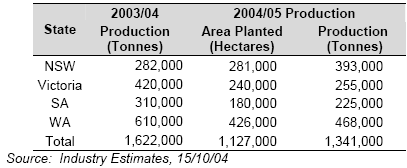Australia
October, 2004
Australian Oilseeds
Federation - Canola Crop Report 2004/05
Weather takes it toll on the canola crop, with
production estimates down 16%.
 Despite
a general rain event in late September across much of New
South Wales (NSW), the onset of high temperatures and heavy
insect pressure have drooped production potential by 58,500
tonnes to 393,000 tonnes during the past month. The combination
of low subsoil moisture levels and the crops being 2-3 weeks
later than normal has increased the severity of the impact
following the abnormally hot spring conditions. Crops in the
central and south west have been hit hardest by the hot weather
while the more advanced crops in the north of the states have
faired better. In the driest areas in the south west, some
farmer have already fed some canola crops to sheep. Windrowing
has commenced in northern NSW and harvest will commence in the
next 10 days. Despite
a general rain event in late September across much of New
South Wales (NSW), the onset of high temperatures and heavy
insect pressure have drooped production potential by 58,500
tonnes to 393,000 tonnes during the past month. The combination
of low subsoil moisture levels and the crops being 2-3 weeks
later than normal has increased the severity of the impact
following the abnormally hot spring conditions. Crops in the
central and south west have been hit hardest by the hot weather
while the more advanced crops in the north of the states have
faired better. In the driest areas in the south west, some
farmer have already fed some canola crops to sheep. Windrowing
has commenced in northern NSW and harvest will commence in the
next 10 days.
Above average temperatures and hot
winds in the last week in the Wimmera, Mallee and North East has
also taken toll on Victorian canola production. There
were widespread reports of canola crops aborting flowering and
thereby limiting pod set after the hot weather. In the Wimmera
and North East of the state canola yield potential is forecast
to drop by 30% and total state production is down by 105,000
tonnes to 255,000 tonnes.
Prevailing winds and hot
temperatures from central Australia also hit South Australian
canola crops. Areas, such as the Eyre Peninsula, Mid North and
Mallee, with had limited soil moisture reserves were hardest hit
as temperatures exceeded 40 deg in some areas in the early part
of this week. The South East of the state faired better as they
escaped the brunt of the higher temperatures. Canola production
in South Australia has been dropped by 45,000 tonnes to 225,000
tonnes.
Rains in the past 10 days in the
Geraldton region of Western Australia have secured canola
crops and ensure reasonable quality. Canola attributed to the
Albany and Kwinana ports is drying off and looking for rain
within the next 10 days to maintain yield potential. Crops in
the Esperance regions have been losing yield because of dry
conditions and rain is required to stop further yield losses.
Western Australian canola production has been reduced by 40,500
tonnes to 468,000 tonnes.
Copyright© Information has been obtained from
sources believed to be reliable, however, AOF is not responsible
for the accuracy or completeness of any information contained
herein and is not responsible for, nor liable for, the results
incurred from their use. |